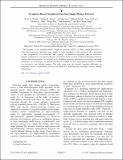| dc.contributor.author | Lee, Gil-Ho | |
| dc.contributor.author | Crossno, Jesse | |
| dc.contributor.author | Ohki, Thomas A. | |
| dc.contributor.author | Kim, Philip | |
| dc.contributor.author | Fong, Kin Chung | |
| dc.contributor.author | Walsh, Evan Daniel | |
| dc.contributor.author | Efetov, Dmitri | |
| dc.contributor.author | Heuck, Mikkel | |
| dc.contributor.author | Englund, Dirk R. | |
| dc.date.accessioned | 2018-02-12T18:11:13Z | |
| dc.date.available | 2018-02-12T18:11:13Z | |
| dc.date.issued | 2017-08 | |
| dc.date.submitted | 2017-03 | |
| dc.identifier.issn | 2331-7019 | |
| dc.identifier.uri | http://hdl.handle.net/1721.1/113588 | |
| dc.description.abstract | We propose to use graphene-based Josephson junctions (GJJs) to detect single photons in a wide electromagnetic spectrum from visible to radio frequencies. Our approach takes advantage of the exceptionally low electronic heat capacity of monolayer graphene and its constricted thermal conductance to its phonon degrees of freedom. Such a system could provide high-sensitivity photon detection required for research areas including quantum information processing and radio astronomy. As an example, we present our device concepts for GJJ single-photon detectors in both the microwave and infrared regimes. The dark count rate and intrinsic quantum efficiency are computed based on parameters from a measured GJJ, demonstrating feasibility within existing technologies. | en_US |
| dc.description.sponsorship | United States. Office of Naval Research (N00014-14-1- 0349) | en_US |
| dc.publisher | American Physical Society | en_US |
| dc.relation.isversionof | http://dx.doi.org/10.1103/PhysRevApplied.8.024022 | en_US |
| dc.rights | Article is made available in accordance with the publisher's policy and may be subject to US copyright law. Please refer to the publisher's site for terms of use. | en_US |
| dc.source | American Physical Society | en_US |
| dc.title | Graphene-Based Josephson-Junction Single-Photon Detector | en_US |
| dc.type | Article | en_US |
| dc.identifier.citation | Walsh, Evan D., et al. “Graphene-Based Josephson-Junction Single-Photon Detector.” Physical Review Applied, vol. 8, no. 2, Aug. 2017. © 2017 American Physical Society | en_US |
| dc.contributor.department | Massachusetts Institute of Technology. Department of Electrical Engineering and Computer Science | en_US |
| dc.contributor.department | Massachusetts Institute of Technology. Research Laboratory of Electronics | en_US |
| dc.contributor.mitauthor | Walsh, Evan Daniel | |
| dc.contributor.mitauthor | Efetov, Dmitri | |
| dc.contributor.mitauthor | Heuck, Mikkel | |
| dc.contributor.mitauthor | Englund, Dirk R. | |
| dc.relation.journal | Physical Review Applied | en_US |
| dc.eprint.version | Final published version | en_US |
| dc.type.uri | http://purl.org/eprint/type/JournalArticle | en_US |
| eprint.status | http://purl.org/eprint/status/PeerReviewed | en_US |
| dc.date.updated | 2017-11-14T22:46:38Z | |
| dc.language.rfc3066 | en | |
| dc.rights.holder | American Physical Society | |
| dspace.orderedauthors | Walsh, Evan D.; Efetov, Dmitri K.; Lee, Gil-Ho; Heuck, Mikkel; Crossno, Jesse; Ohki, Thomas A.; Kim, Philip; Englund, Dirk; Fong, Kin Chung | en_US |
| dspace.embargo.terms | N | en_US |
| dc.identifier.orcid | https://orcid.org/0000-0001-5862-0462 | |
| dc.identifier.orcid | https://orcid.org/0000-0001-7175-4473 | |
| mit.license | PUBLISHER_POLICY | en_US |
